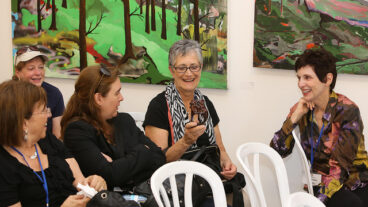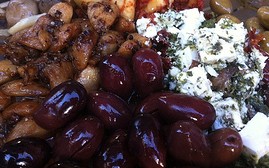This country has created a mass culture that’s very strong and long-lasting, like a cactus. Even after 15 years of watching NBA basketball on cable, of seeing the best players in the world from Larry Bird to Michael Jordan to Kobe Bryant, Israelis still go crazy over Maccabi Tel Aviv.
About 11,500 of them followed the team to Prague last week for the European Cup final – to watch a bunch of American NBA rejects plus somebody named Burstein along with their coach Pini Gershon, the most Israeli Israeli alive.
I went into the local music store and asked the owner which foreign musicians were the most popular. “Kelly Clarkson, Coldplay, Madonna, Black Eyed Peas, Prince,” he said. What about Israeli musicians?” Miri Mesika, Metropolitan, Fortis-Sakharov, Aviv Geffen.”
Who sells more?
“The Israelis,” he said.
In case anybody hasn’t noticed, McDonald’s has replaced McDavid’s as the national hamburger joint. There’s also Domino’s pizza and Sbarro’s pizza and Pizza Hut. When I look through the restaurant listings, especially in Tel Aviv, I find gourmet and ethnic restaurants with food from countries I’ve never heard of. Israelis have become truly international fressers – yet they haven’t lost their taste for falafel, shwarma, humous, kebab or shishlik at all.
As long as I can remember, people here have been complaining about how Israeli popular culture is being swallowed up by American popular culture, which has become global popular culture. Hebrew is being elbowed out by English, they say – look at the ads and commercial signs. Or look at TV and the Internet.
And if it isn’t American popular culture that’s taking over, it’s Latin America popular culture with those telenovelas that turned millions of Israeli mothers and daughters into zombies. Or it’s Japanese popular culture with Pokemon, which turned millions of Israeli boys into Attention Deficit Disorder cases.
However, all grumbling aside, the fact remains that most TV programs Israelis watch are homemade, in Hebrew. And the most popular program of all, the undisputed king of Israeli popular culture, is the TV news satire Eretz Nehederet (A Wonderful Country), which is purely, uniquely, brilliantly Israeli.
It turns out that this country has created a mass culture that’s very strong and long-lasting, like a cactus. That’s not a small accomplishment, considering the way modern Israel was thrown together in only a century or so from bits and pieces around the world, with a creaky, anachronistic language pressed into service to hold them together.
This mass culture is resilient enough to exist easily alongside whatever America and the rest of the world send our way. And Israelis are so deeply attached to their own popular culture that they don’t have to choose between the local and the global – they can, and do, have them both.
My 10-year-old, Israeli-born son Alon is a perfect example. On the walls of his bedroom are posters of Barcelona soccer star Ronaldinho, Canadian wrestler Chris Benoit, and former Maccabi Tel Aviv soccer star Baruch Dego. He’s got a Maccabi Tel Aviv scarf and a Chelsea jersey. Like every Israeli sports fan, he’s got his local favorite and his foreign favorite, and his enthusiasm for one doesn’t come at the expense of his enthusiasm for the other.
I can think of only two features of Israeli popular culture that have been rubbed out completely by the imports. One is clothing. There used to be distinctively Israeli fashion – shirts with extra-wide, floppy collars, plain “Biblical” sandals and, of course, the kova tembel, or modified dunce cap. You don’t see them anymore, except for the occasional old sandal; now Israelis dress like up-to-date people anywhere in the world. Recalling the old sabra attire, though, the loss in distinctiveness is more than made up for by the gain in looks.
The other part of Israeli popular culture that went purely global is architecture. Those blocks of tenement boxes and fortress-like public buildings that went up in the 1950s, and which reflected the strong, austere self-image of the new socialist, militarist state, are now relics, nostalgia. The new Israeli architecture is all high tech and “classy”; I can’t see anything identifiably Israeli about it at all. (Except for the airport’s Terminal 3, which is a wonder.)
But again, if you drive through the old neighborhoods of Tel Aviv or Haifa and look at those crumbling beige stucco cubes, you’ll probably agree that truly indigenous architecture can also be ugly as sin.
I’m not saying that all Israeli popular culture is good, or even good on balance, or better than that of other countries. A lot of it is pure garbage. Worst of all is the popular use of Hebrew; it’s usually so vague and inexpressive until it’s down to a collection of cliches. And a good deal of Israeli popular culture is just a knock-off of junk global culture, like reality TV shows and soap operas. And if there’s one thing in the world that’s worse than English-language rap, it’s Hebrew rap.
Furthermore, I wish more Israelis would expose themselves to some interesting global popular culture instead of the lowest common denominator. Above all, I wish they would learn the global language, beyond being able to say, “What’s up, man?”
But we’re making big strides. Israeli movies used to be about at the level of Israeli boxing, but in recent years a number of really good, really Israeli movies have come out – The Syrian Bride, Free Zone, Ushpizin and others. Also, Israeli popular culture has become more Mizrahi, which makes it not only more at home in the Middle East, but also just plain better; let’s face it, when it comes to food, popular music and soccer, Mizrahim beat the hell out of Ashkenazim.
I don’t know if popular culture in other countries is holding up to the American and global challenge as well as, better than, or worse than ours is. And I don’t know if the resilience of ours has more to do with its quality, or just because people everywhere like what they know, what they understand, what says “home” to them.
But at the absolute least, the vitality of Israeli popular culture shows that this country is not an artificial “foreign implant,” nor is it a melting pot that didn’t melt. Nope, this ad hoc society has created something new, something of its own, something that includes its share of junk, but at least its share of jewels as well.
And after 58 years of national sovereignty, this society’s creative process is continuing, for better and worse. Like that old local export to the global T-shirt culture used to put it, Israel is real.
Reprinted with permission from The Jerusalem Post.












